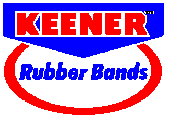
Keener Rubber Company
Keener
produces all our rubber bands from the highest grade of natural and synthetic
rubber available
|
Keener Rubber Company
|
|
|
Specifications of Rubber & Glossary of Terms How to choose the best type of rubber for your application
conversion from Centigrade (c) to Fahrenheit (f): f=[9/5c] +32 Glossary of Terms Technical specification line callout can be found in ASTM D2000 & BS 5176 (BS 1154 - natural rubber) Accelerators- Chemicals added to rubber to accelerate the rate of vulcanization. Aging - Accelerated aging tests are performed to determine the destructive influence of light, oxygen, heat and ozone on the rubber band. Natural aging requires many years of proper and controlled evaluation, therefore, accelerated aging tests will give comparative values in short periods of time. There is no absolute correlation between natural and accelerated aging. Activators- Chemicals that are added to rubber to activate the curing process. Bloom - A light colored deposit on the surface of rubber related to solubility of chemicals. Clay - A common extender in rubber; can be used as a reinforcement agent. Compound - The recipe for a particular rubber compound. Compression Set - The degree to which rubber does not recover fully to its original state under the application of stress. It actually is a characteristic of liquids and is usually referred to as hot-flow or cold-flow. Corona Resistance - The ability of rubber acting as an insulator to withstand the affects of high voltage discharge. Curatives - General term used to describe the chemicals used in the curing of rubber Curing - Rubber is cured to undergo a permanent change to a solid, heat stable state Dielectric Properties - The ability of material to resist the puncture due to electrical stress. Expressed in terms of volts per MIL thickness. Durometer - Also referred to as hardness. Can be described as the resistance of rubber to indentation. The most common instrument used to determine this is the Durometer, hence the name. ASTM D2240, A Scale, is used for testing most compounds. The results are scaled 00 to 100 with 100 being the hardest. Indentation hardness is dependent on elastic modulas and viscoelastic behavior of the compound. Rubber compounds which are not completely elastic will "creep" during the test. This creep is noted as the difference between the initial hardness reading and the reading after 15 seconds of engagement. A properly noted reading is expressed as follows: Durometer A 50, creep 5 at 15 seconds. 73F. Elastomer - Generic term for all natural and synthetic material that express elastic properties. Extrusion - Production of a length of rubber tubing with a specific profile by pushing it through a die. In the case of rubber bands, producing a tube with a specific inner and outer diameter. Fillers - General term used for bulk materials added to a compound. Flex cracking - Describing the result of bending and stressing at the same point. Hystereis - The difference between the amount of energy absorbed when rubber is stretched and the amount of energy released when it is then relaxed. Modulus - The relationship between stress (force) and strain (extended length). Expressed as force at a certain percentage of elongation. Permanent Set - When a rubber band is stretched and released it does not return to its exact original length but comes to rest somewhat longer than it was before being stretched. The increase in length of the band, expressed as a percent of the original length, is called permanent set. Plasticisers - Liquids used to soften rubber. Resilience - Describes the snap or bounce. Generally expressed in the percentage of the ratio of energy returned by rubber to the energy used in compressing the rubber. Set - The degree to which a rubber band does not return to its original length after being stretched. Specific Gravity - The ratio of the weight of the given bulk to that of the same bulk of water. Tear Resistance - The measurement of the resistance of growth of a nick or cut when tension is applied to the cut sample. Tensile Strength - The tensile strength of a rubber compound is in its resistance to rupture under tension. It is measured as strength at break and is expressed in pounds per inch of cross section. This property has an absolute value in some applications where the band is actually subjected to tension in service but, like the other tensile properties, it is most frequently used in evaluating compound materials on a cooperative basis. In a series of cures with a variable time factor the tensile strength either passes through a maximum or exhibits a marked change in the slope of its curve. Therefore, the tensile strength may be considered either separately or together with the modulas and elongation in defining an optimum state of cure for any specific compound. Vulcanization - Describes the process of creating the permanent change of rubber upon heating with the appropriate facilitating chemicals.
|
Send mail to webmaster@keenerrubber.com with
questions or comments about this web site.
|